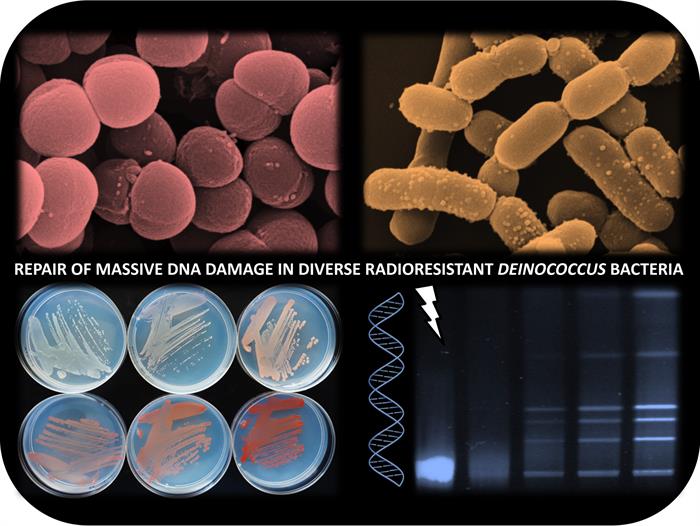Radiation resistance has been observed for a few organisms among bacteria, archaea and small invertebrates, and has been studied most extensively for Deinococcus bacteria. The latter are extremely radioresistant, tolerating doses of ionizing radiation up to 5000 Gy (Gray2) without loss of viability, whereas 200 Gy is lethal for most bacteria and exposure to only 5 to 10 Gy is sufficient to kill human cells. Elucidating how Deinococci resist radiation may lead to a better understanding of radiation resistance of other organisms or cells (e.g. some cancer cells with increased resistance to radiotherapy), or conversely, to an understanding of why some cells are more radiosensitive than others.
In 2014, an American research team3 obtained, by directed evolution4, radioresistant Escherichia coli bacteria (3000 Gy) after repeated irradiations in the laboratory. These studies showed that the radiation resistance mechanisms conferred by directed evolution are multifactorial and partially different from the mechanisms developed through natural evolution as described for the bacterium Deinococcus radiodurans.
What is the origin of Deinococcus' radiation resistance ?
Radiation resistance in D. radiodurans results from a combination of different physiological determinants associated with well-regulated molecular mechanisms (protection of proteins against oxidative damage by efficient enzymatic and non-enzymatic antioxidant systems, repair of massive DNA damage involving some enzymes that have characteristics different from those of E. coli, implication of Deinococcus specific proteins).
Beyond the model species D. radiodurans, many radioresistant Deinococcus species, whose genomes are known to researchers, have been isolated from various environments worldwide (hot and dry deserts, hot springs, Antarctica, etc.). In 2016, a French-Korean collaboration begins. Scientists then start to explore this biodiversity in depth to see common points or specificities, and whether the radiation resistance mechanisms testify to the great capacity of living organisms to generate novelty without an established model.
1 Within BIAM, the Institute of Biosciences and Biotechnologies of Aix-Marseille (CEA/CNRS/Université Aix-Marseille).
2 The Gray (Gy) is the SI unit of the absorbed dose of ionizing radiation, corresponding to one joule per kilogram. 1 Gy = 1 J/kg.
3 Michael Cox's team in Madison (USA) and his collaborators.
4 The directed evolution in this case consists of repeated irradiations with sub-lethal doses. Surviving cells are resubmitted to an incremented dose, over several cycles, to increase radioresistance.
The authors of this work reviewed all the mechanisms and factors involved in oxidative stress resistance and DNA repair. The results of this meta-analysis of 296 publications, covering more than 250 proteins on a set of 11 genomes, allow defining the partition and the role of each interpreter.
In the end, this study reveals an unsuspected diversity of mechanisms that can be used to achieve effective radiation resistance, even within very close species. The article provides a leading reference and thought-provoking perspectives giving ideas for specialists in various fields. Among these, characterize the regulation of other defence mechanisms developed by bacteria, including bacteria pathogenic to humans, decipher new DNA repair mechanisms, better understand the radioresistance developed by some cancer cells.

© KAERI/A. De Groot